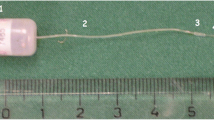Summary
Cerebrospinal fluid (CSF) derived from six patients with polyradiculoneuritis (Guillain-Barré syndrome, GBS) treated by liquorpheresis was injected into rat sciatic nerve. By measuring spinal evoked potentials after stimulation of the tibial nerve, we observed slowing or dispersion of nerve conduction in those cases where the CSF had been taken before liquorpheresis. CSF of the same patient, sampled after liquorpheresis, showed minor effects only. Impairment of nerve conduction was seen between 5 and 20 min after injection, normal function being restored on the third day. These results suggest that liquorpheresis eliminates blocking factors from the CSF of patients with GBS. We postulate this as the effect by which liquorpheresis improves neurological symptoms in Guillain-Barré syndrome.
Similar content being viewed by others
References
Feasby TE, Hahn AF, Gilbert JJ (1982) Passive transfer studies in Guillain-Barré polyneuropathy. Neurology 32: 1159–1167
Harrison BM, Hansen LA, Pollard JD, McLeod JG (1984) Demyelination induced by serum from patients with Guillain-Barré syndrome. Ann Neurol 15:163–170
Hülser P-J, Wiethölter H (1986) The anterior root response in the lumbar SEP of rat after stimulation of the tibial neerve. Electromyogr Clin Neurophysiol 26:49–55
Lassmann H, Kitz K, Wisniewski HM (1981) In vivo effect of sera from animals with chronic relapsing experimental allergic encephalomyelitis on central and peripheral myelin. Acta neuropathol (Berl) 55:297–306
Saida K, Saida T, Brown MJ, Silberberg DH, Asbury AK (1978) Antiserum mediated demyelination in vivo—a sequential study using intraneural injection of experimental allergic neuritis serum. Lab Invest 39:449–462
Saida T, Saida K, Lisak RP, Brown MJ, Silberberg DH, Asbury AK (1982) In vivo demyelinating activity of sera from patients with Guillain-Barré syndrome. Ann Neurol 11:69–75
Schabet M, Schott K, Stevens A, Wiethölter H (1989) Therapie der experimentellen allergischen Neuritis (EAN) mit Protease-Inhibitoren. In Fischer PA, Baas H, Enzensberger W (eds) Verhandlungen der Deutschen Gesellschaft für Neurologie 5, Springer Berlin Heidelberg New York London Paris Tokyo Hong Kong, pp 1161–1163
Sumner A, Said G, Idy I, Metral S (1982) Syndrome de Guillain-Barré. Effects électrophysiologiques et morphologiques du sérum humain introduit dans l'espace endoneural du nerf sciatique du rat. Résultants préliminaires. Rev Neurol (Paris) 138, 1:17–24
Wiethölter H (1989) Verlaufsformen der experimentell-allergischen neuritis. Springer, Berlin Heidelberg New York London Paris Tokyo
Wollinsky KH, Mehrkens H-H, Hülser P-J, Weindler M, Geiger P, Matzek N, Kornhuber HH (1989) Liquorpherese, Liquorfiltration als neues Therapieverfahren bei der Behandlung eines schweren Guillain-Barré Syndromes. Anaesthesist 38 Suppl 1:630
Author information
Authors and Affiliations
Rights and permissions
About this article
Cite this article
Hülser, P.J., Wiethölter, H. & Wollinsky, K.H. Liquorpheresis eliminates blocking factors from cerebrospinal fluid in polyradiculoneuritis (Guillain-Barré syndrome). Eur Arch Psychiatry Clin Nuerosci 241, 69–72 (1991). https://doi.org/10.1007/BF02191142
Received:
Issue Date:
DOI: https://doi.org/10.1007/BF02191142




